Induction Stove Pans & Cookware: Expert Tips for Buyers
Updated: 29 Jun 2025
176
Are all your pots and pans really ready for your induction stove—or have you been cooking the wrong way all along? Many homeowners assume any cookware will do, but that’s far from true. In fact, using the wrong cookware can lead to poor heating, wasted energy, and even damage to your cooktop.
If you’ve just bought an induction stove or are thinking about switching, the biggest question is: what kind of cookware do I actually need? The truth is, not all pans are compatible. Many people are surprised when their favorite non-stick or aluminum cookware won’t even heat up.
In this post, you’ll learn everything you need to know about induction stove cookware—from how to test if your pans will work, to the best cookware for beginners, and common mistakes to avoid.
Why Regular Cookware Doesn’t Always Work on Induction
You might be wondering, “Why won’t my regular cookware heat up on an induction stove?” It’s a common issue. The answer lies in how induction cooking works.
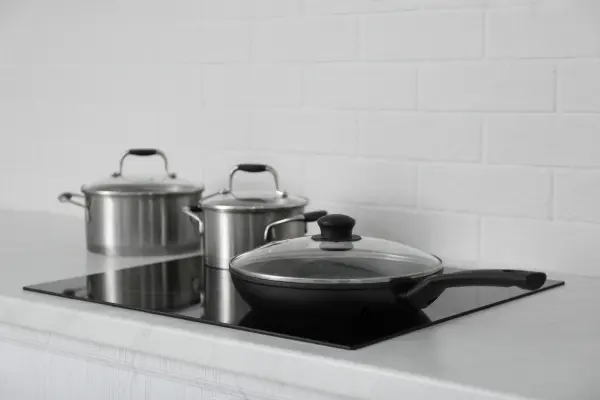
Unlike gas or electric stoves, induction stoves use magnetic energy to heat the cookware directly. So, unless your pots and pans have a magnetic base, they won’t work. That’s why glass, aluminum, and copper pans often fail on induction stoves.
Difference Between Induction and Regular Cookware
Here’s what separates them:
- Induction stove pans must contain ferrous metal (iron or steel) at the base.
- Regular pans, especially non-magnetic stainless steel or pure aluminum, won’t respond to the induction coil.
How to Know If Your Current Cookware Will Work
Testing your cookware is easy. You don’t need special tools—just a magnet.
How to Test Cookware for an Induction Stove
Here’s a simple step-by-step test:
- Grab a fridge magnet.
- Stick it to the bottom of the pot or pan.
- If it sticks firmly, it’s good to go.
- If it doesn’t stick or slide off, it won’t work.
That’s it! This quick trick tells you whether your pan is safe for induction stoves.
Why Some Cookware Still Fails
Even if the magnet test works, some pans heat poorly or make loud buzzing sounds. This happens when:
- The base is too thin
- The pan is too small for the burner
- The surface isn’t completely flat
What Pans Work with Induction Stoves?
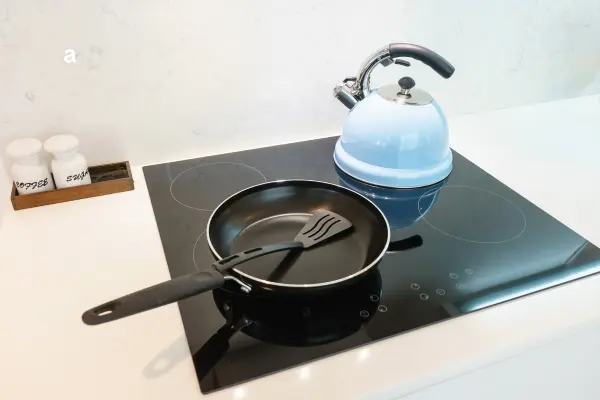
Not every pan works on induction, and many people learn that the hard way. So, what exactly works with induction stoves, and why?
To keep it simple, Induction stove cookware must be made with materials that react to magnetic energy. If it doesn’t have a ferromagnetic base, it simply won’t heat up.
Here’s a breakdown of the different cookware materials that are safe for induction stove pans:
Materials That Work
- Cast Iron
- Naturally magnetic
- Heats evenly and retains heat
- Heavy but ideal for frying, searing, and simmering
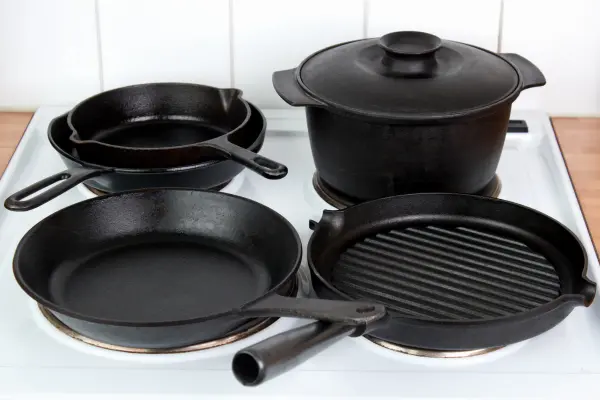
- Enameled Cast Iron
- Same benefits as regular cast iron
- Non-reactive and easier to clean
- Perfect for stews, curries, and one-pot meals
- Magnetic Stainless Steel
- Durable, rust-resistant, and sleek
- Look for grade 430 stainless steel (magnetic)
- Ideal for daily cooking
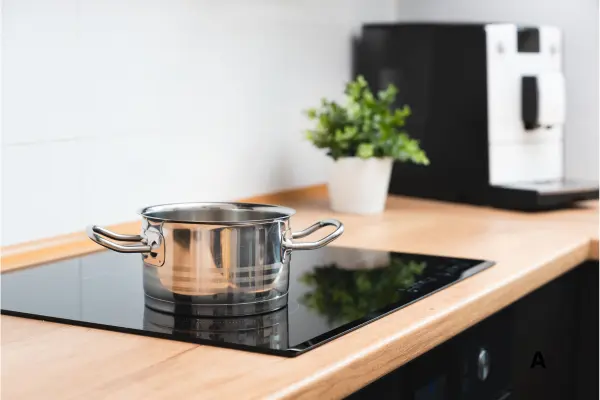
- Carbon Steel
- Lighter than cast iron but with similar benefits
- Great for woks and skillets
- Multi-Layered Cookware
- An aluminum core sandwiched between magnetic steel
- Best of both worlds: fast heating + induction compatibility
Materials That Don’t Work
- Pure Aluminum or Copper
- Not magnetic unless fused with steel
- Lightweight but incompatible by themselves
- Glass or Ceramic
- Zero magnetic reaction
- May crack due to uneven heating
- Non-Magnetic Stainless Steel (e.g., 18/10)
- Premium look, poor compatibility
To learn more about how induction technology interacts with materials, check this source from the US Department of Energy.
Best Cookware for Induction Stove Beginners
You don’t need to replace every pot in your kitchen. Instead, invest in a few reliable induction stove pans that suit your cooking style. Here’s a complete guide for you
Best Cookware for Induction Stove Beginners
When shopping for beginner-friendly sets, focus on:
- Durability
- Magnetic compatibility
- Easy handling and cleaning
- Value for money
Below are top picks that are beginner-safe and perform well on induction:
T-fal Professional Nonstick Induction Fry Pan
- Non-stick with magnetic base
- Great for eggs, pancakes, and stir-fry
- Affordable and reliable
Duxtop Stainless Steel Induction Cookware Set
- 10-piece starter set
- Tri-ply base (aluminum + stainless + magnetic)
- Oven-safe and dishwasher-friendly
Lodge Cast Iron Skillet
- Perfect for searing and deep frying
- Works on induction, gas, electric, and in the oven
- Built to last a lifetime
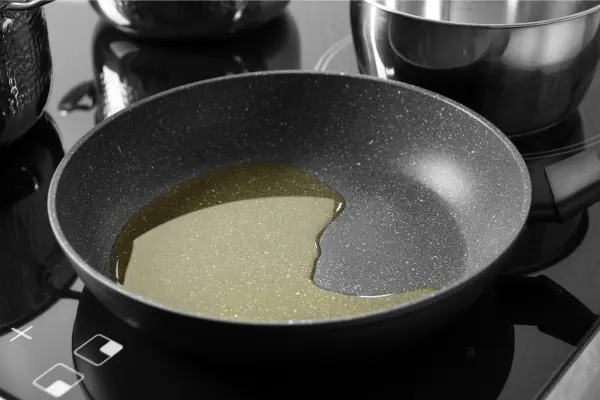
Comparison Table – Best Induction Cookware Sets for Beginners
| Cookware Set | Material | Pieces | Compatible With | User Rating |
|---|---|---|---|---|
| Duxtop Professional 10-Piece | Tri-Ply Stainless Steel | 10 | Induction, Gas, Electric, Ceramic | ⭐⭐⭐⭐☆ (4.5/5) |
| T-fal Ultimate Hard Anodized | Non-stick with Magnetic Base | 12 | Induction, Gas, Electric | ⭐⭐⭐⭐ (4.4/5) |
| Amazon Basics Induction Set | Aluminum + Magnetic Steel Base | 8 | Induction Only | ⭐⭐⭐⭐ (4.3/5) |
| Lodge Cast Iron Skillet (Single) | Cast Iron | 1 | All Cooktops + Oven Safe | ⭐⭐⭐⭐⭐ (4.8/5) |
Can You Use Aluminum, Copper, or Glass on Induction?
Here’s the truth—most aluminum, copper, or glass pans won’t work on an induction stove. These materials simply lack magnetic properties.
However, aluminum pans can work if they have a fused magnetic steel base. This is common in newer models labeled “induction-compatible.” If you’re asking, “Can I use aluminum pans on an induction stove?”, the answer is: only if the base is magnetic.
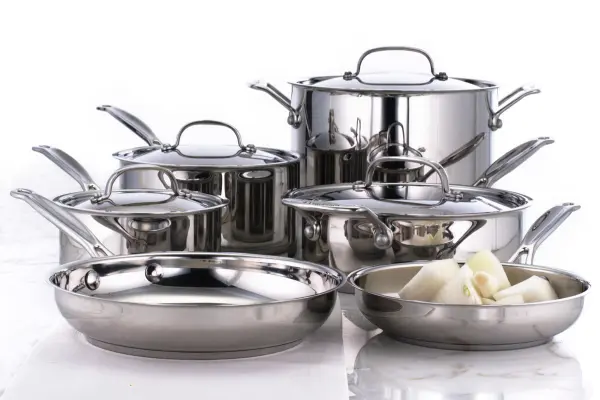
Common Myths to Avoid
- “You can use any pan with an adapter plate.”
→ You can, but it reduces efficiency and heats more slowly. - “All non-stick pans are induction-compatible.”
→ Many aren’t. Always check the base or label.
Common Problems with Induction Cookware
If your cookware isn’t working as expected, don’t worry—you’re not alone. Many users face the same issues. Let’s break down why your induction cookware might not be working.
Top Problems and Fixes
- Cookware not detected
→ The base is too small or not magnetic enough - Uneven heating
→ Thin base or warped bottom
→ Solution: Use flat, heavy-bottomed pans - Buzzing or vibrating sounds
→ Thin metal layers vibrate under electromagnetic force
→ Try heavier induction stove pans - Heating only on one burner
→ Burner may have a minimum pan size requirement (check manual)
Cookware Compatibility with Other Stoves
Good news! Most induction cookware also works on gas and electric stoves.
This makes induction-compatible pans a smart long-term investment, especially for multi-fuel kitchens or RVs.
Induction Cookware That Works on Gas Stoves Too
Look for these labels:
- Multi-surface compatible
- Oven safe + gas safe
- Heavy base with magnetized layers
Materials like cast iron, carbon steel, and magnetic stainless steel are perfect for all stove types.
Affordable Induction Stove Cookware Sets for Every Kitchen
Looking to upgrade without breaking the bank? Here are the best affordable induction stove cookware sets that combine quality with value.
Top Budget-Friendly Sets
Duxtop Professional Stainless Steel (10-Piece Set)
- Durable tri-ply construction
- Works on all stoves
- Dishwasher and oven-safe
- Ideal for beginners
Amazon Basics Nonstick Induction Cookware Set
- Magnetic base + easy non-stick cooking
- Lightweight and affordable
- Great for small kitchens or college students
T-fal Ultimate Hard Anodized Induction Set
- Strong non-stick coating
- Heat indicator for easy preheating
- Even heat distribution
Induction Stove Cookware Compatibility List
Below is a quick guide to common cookware brands and their induction compatibility:
| Brand | Induction-Compatible | Notes |
|---|---|---|
| All-Clad | Yes | Tri-ply and D3 lines work well |
| T-fal | Yes | Check for “Induction” on the label |
| Cuisinart | Yes (select lines) | Look for Multiclad Pro series |
| Calphalon | No (unless specified) | Some lines lack magnetic bases |
| Lodge | Yes | All cast iron is induction-safe |
| GreenLife | No (most lines) | Ceramic coating, not magnetic |
Expert Tips for Maintaining Induction Cookware
Want your cookware to last longer and cook better? Follow these expert tips:
Care and Maintenance Tips
- Don’t overheat empty pans
- Use wooden or silicone utensils to avoid scratching
- Always dry cast iron completely after washing
- Avoid using abrasive sponges on non-stick pans
- Store with pan protectors to avoid surface scratches
For more tips, you can also follow 11 Practical Care and Maintenance Tips for Electric Stoves
FAQs
1. Why do my induction pans make noise?
Buzzing or humming often happens with thin or lightweight pans. Thicker cookware minimizes the noise.
2. Are there induction pressure cookers?
Yes! Brands like Prestige and Fissler offer induction-compatible models.
3. Why does a pan work on one burner but not the other?
Burner may have a minimum size requirement or better sensitivity.
4. Should a beginner buy a Full Set or Mix & Match?
This is a common beginner’s dilemma. The answer depends on:
Storage space
Your budget
Your cooking habits
| Remember |
|---|
Remember, the quality of your cookware affects your cooking speed, energy use, and even how your food tastes. |
Final Thoughts: Invest Smart, Cook Better
Choosing the right induction stove cookware is essential if you want to cook efficiently and safely. Not all pots and pans will work. You need ones with a magnetic base to heat properly on an induction stove.
Whether you’re a beginner or upgrading your kitchen, start with a few induction-compatible pans and build from there. Always look for labels or symbols that confirm induction support.
So, take the time to choose the right cookware for induction stoves—it’s a smart move for your kitchen and your meals.
References
https://www.energy.gov/eere/ammto/next-generation-materials
https://www.whirlpool.com/blog/kitchen/induction-cookware-guide.html
https://www.thespruceeats.com/what-is-the-best-cookware-for-induction-cooktops-908920
Please Write Your Comments